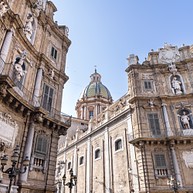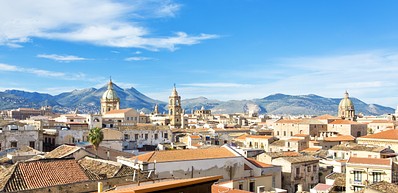
-
![Museo Diocesano di Palermo]() Provided by: Colsu/CC BY-SA 4.0/Wikimedia
Provided by: Colsu/CC BY-SA 4.0/Wikimedia

Our travel guides are free to read and explore online. If you want to get your own copy, the full travel guide for this destination is available to you offline* to bring along anywhere or print for your trip.
*this will be downloaded as a PDF.Price
€4,95
Diocesan Museum
The guide was updated:Housed in the Archbishop's Palace, the Museo Diocesano di Palermo boasts an impressive collection of sculptures from the 15th to 18th centuries. It also displays interesting artworks, such as religious silverware and textiles, frescoes and Italian and Flemish paintings from the 16th to 19th centuries.
Useful Information
- Address: Via Matteo Bonello 2, Palermo
- More Info: Last admission 30 minutes before closing time
- Opening hours: Daily 9am–6pm
- Website: www.museodiocesanopa.it
- Phone: +39 091 607 7303
- Email: museo@chiesadipalermo.it
Digital Travel Guide Download
Our travel guides are free to read and explore online. If you want to get your own copy, the full travel guide for this destination is available to you offline* to bring along anywhere or print for your trip.
*this will be downloaded as a PDF.Price
€4,95

The former royal palace of King Roger II in the 1100s, Palazzo dei Normanni is one of the most famous sights in Palermo. Dating back to the 9th century, the palace owes its current appearance to the embellishments realised by the Normans: covered in dazzling Byzantine mosaics, the Arab-Norman architecture is a symbol of the political and cultural union operated by the Normans. Be sure to check out the stunning Palatine Chapel.
Read more

Cappella Palatina
Located inside Normans Palace (Palazzo dei Normanni), the royal chapel of the Norman kings of Sicily, Cappella Palatina is the finest example of Arab-Norman art in the city. Every inch is a jubilation of craftsmanship, from the golden mosaics covering the walls to the marble floors and carved wooden ceilings.
Read more

Piazza Pretoria
The grandiose Piazza Pretoria captivates with its fountain, spreading proudly in front of Palazzo Pretorio (City Hall) as one of the major symbols of Palermo. The Pretoria Fountain was sculpted by Francesco Camilliani in 1574 and initially placed in Florence for a few years. It was then bought by the municipality and transported to Palermo. The fountain is a true masterpiece and is considered one of the most beautiful fountains in Italy. The nude figures adorning the fountain have got the most prudish population in the city to nickname the square "Piazza della Vergogna", (Square of Shame).
Read more

Palermo Cathedral
One of the major examples of Sicily's unique encounter of architectonic styles, the Palermo Cathedral is the result of centuries of additions, redecoration, and restorations. It was built in 1185 on the site of a former Byzantine church, which was used as a mosque during the 9th century and it encompasses Medieval, Gothic, Arabic, and Neoclassical styles. Climb up to the roof and enjoy a great view of the city.
Read more

Quattro Canti
Officially known as Piazza Vigliena, Quattro Canti is considered one of the most fascinating landmarks of Palermo. Located at the intersection of Via Maqueda and Corso Vittorio Emanuele, it has an octagonal structure shaped by the elegant facades of the buildings standing at its corners. During the day, the sun is always shining on at least one of the four facades: leading to this Baroque gem being nicknamed by locals "il teatro del sole" ("the theatre of the sun").
Read more

Teatro Massimo
A Neoclassical masterpiece, Teatro Massimo is one of the largest opera houses in Europe. Opened in 1897, it is the lyrical temple of the city, staging the opera and ballet official season. The flamboyant interiors can be visited with a 30-minute tour available daily in several languages.
Read more

Majolica Museum "Stanze al Genio"
A hidden gem in Palermo, Stanze al Genio is a private collection of nearly 5,000 intricately crafted majolica tiles, spanning from 15th to 20th century Sicily and Campania. Adorning the walls and floors of the 16th-century Palazzo Torre Pirajno's piano nobile, these hand-painted tiles resonate with artistic history. On display is also a small collection of vintage stationery and Italian toys. Visits are possible only via guided tours that must be booked in advance.
Read more

Church of Saint Catherine of Alexandria
The Chiesa di Santa Caterina d'Alessandria in Palermo attracts visitors from all corners of the globe with its remarkable Sicilian Baroque architecture and ornate decor: the walls are full of ornamental paintings and there are vibrant frescoes, intricately carved statues, and stunning colourful marble interiors. Don't miss out on the magnificent majolica cloister and the view from the rooftop terrace. The bakery located inside the complex sells sweet treats prepared with century-old recipes from Sicily's convents.
Read more

Regional Archeological Museum Antonio Salinas
Housed in a Renaissance monastery, the Regional Archeological Museum Antonio Salinas boasts a rich collection of Roman and Ancient Greek artefacts including many items spanning most of Palermo’s history. The highlights of the exhibition are the decorative friezes from the temples at Selinunte.
Read more

Ballarò Market
The Mercato di Ballarò is the oldest and largest market in Palermo where you can enjoy some exciting flavours and buy fresh produce. Resembling a colourful and buzzing souk, walking down the lanes of this busy street market will immediately show you how Sicily markets developed during the Arab occupation. Part of the experience is the jingles sung by the vendors to attract customers while offering samples to the passers-by.
Read more

Galleria Regionale della Sicilia Palazzo Abatellis
Allegedly the best art gallery in Palermo, the Galleria Regionale della Sicilia Palazzo Abatellis exhibits artworks of Sicilian artists from the Middle Ages, artefacts from the Arab period, and paintings from the 17th and 18th centuries. Take your time to admire the stunning Palazzo Abatellis, built in the 15th century in the Gothic-Catalan style.
Read more

Church of Saint John of the Hermits
One of the finest examples of Medieval architecture in Palermo, the church of Saint John of the Hermits (Chiesa di San Giovanni degli Eremiti) is famous for its red domes and architectural design that was greatly influenced by the Arabs during the 12th century. This was originally a mosque that was later converted into a Christian church dedicated to Sicily's hermit monks. Walk along the pretty garden of regional plants and the ruins of the cloister.
Read more

Botanical Garden
Founded in 1781, the Orto Botanico di Palermo is considered to be a prestigious open-air botanical museum that has enabled in-depth studies on fascinating plants for about 200 years. Walk down the shaded pathways lined with subtropical plants, fig trees, Mediterranean herb gardens, local cacti, and hibiscus but don't forget to also check out the beautiful historical buildings where this restful paradise is set in.
Read more

Zisa Palace
Zisa Palace is a 12th century castle built for King William I of Sicily. Its name derives from the Arabic word "al-Aziz", which means splendid. The original Norman building underwent some changes during the years, especially with the decorations added during the Baroque period. The Islamic inspiration for the architecture is clearly visible in the decorations of the vestibule, where Arabic vaults and columns are interposed by Baroque frescoes and marble decorations. Today, the castle houses a museum of Islamic art.
Read more

Torre di San Nicolò di Bari
Torre di San Nicolò di Bari is a civic tower dating back to the 12th century and located near Mercato di Ballarò. Originally used for defensive purposes, this Medieval tower is today open to visitors who can enjoy a breathtaking view over Palermo's cityscape and its historical buildings.
Read more

Diocesan Museum
Housed in the Archbishop's Palace, the Museo Diocesano di Palermo boasts an impressive collection of sculptures from the 15th to 18th centuries. It also displays interesting artworks, such as religious silverware and textiles, frescoes and Italian and Flemish paintings from the 16th to 19th centuries.
Read more

Palazzo Chiaramonte Steri
Built in the early 14th century in Norman Gothic style, Palazzo Chiaramonte Steri, one of the symbols of Palermo, bears witness to a multifaceted history as both a tribunal and prison under the Inquisition from 1600 to 1782. Today, it serves as the headquarters of the University of Palermo, offering visitors a glimpse into history through its marvellous lecture halls adorned with intricate 14th-century wooden ceilings. The Inquisition Museum within its walls unveils the poignant narratives of prisoners through haunting graffiti and artworks, etching their stories onto the very cells that once confined them.
Read more

Capuchin Catacombs
Located in the Capuchin Monastery since 1599, the Catacombe dei Cappuccini houses 8,000 mummified bodies and skeletons of former residents of Palermo who died between the 17th and 19th centuries. It's a somewhat macabre insight into the customs and traditions of the Palermitan society of the time, with gender, religion, profession, and social status rigidly applied to the disposition of the bodies.
Read more

Art Nouveau Kiosks
The three Art Nouveau kiosks by architect Ernesto Basile appear like unexpected gems along the buzzing streets of Palermo. Built about the end of the 19th century, the kiosks once hosted the traditional Sicilian vendors of soft drinks and refreshing beverages but are today converted into tobacconists.
Chiosco Ribaudo located in Piazza Verdi, the most famous one, is a crimson and wrought iron building adorned with golden letters. The second Ribaudo kiosk in Piazza Castelnuovo is decorated with colourful majolica and mosaics while the Chiosco Vicari, in front of the Teatro Massimo, is a triumph of Moorish, Islamic, and Colonial architecture.
Read more

Festa di Santa Rosalia
Festa di Santa Rosalia is a grand annual festival that takes place in July. The festival, which lasts six days, is dedicated to Saint Rosalia, also called La Santuzza (Little Saint) or Rusulia (in Sicilian dialect), Palermo's patron saint, and it commemorates the miraculous appearances of the saint in 1624 when the city was hit by the plague. This festival is full of dazzling fireworks, religious processions, live music, and sumptuous Sicilian delicacies.
Read more

Nature Reserve of Capo Gallo
A real hidden paradise easily reached with a few minutes walk from Mondello, Capo Gallo is a regional nature reserve encompassing the huge Mount Gallo, ending up in a rocky promontory towered by a lighthouse, some grottos, and hidden sandy beaches surrounded by wild vegetation. Among its inhabitants are falcons, buzzards, and owls, while the reserve beckons adventurers with opportunities for snorkelling, kayaking, and hiking adventures.
Read more

Monreale
This little town with a population of nearly 40,000 lies in the mountains southwest of Palermo. Its postcard-perfect views are only rivalled by the UNESCO-listed Norman masterpiece that is the Monreale Cathedral, Italy’s largest medieval building which holds 6,000 square metres of Byzantine art. One of the most important examples of Norman architecture in Europe, the cathedral is covered in shimmering golden mosaics and also encompasses Arab, Byzantine, and Classical elements.
Read more

Ustica
Ustica is a tiny volcanic island located 52 km from Palermo, which is linked by a regular ferry service. This heavenly retreat offers everything you may expect from a Mediterranean island: hiking trails alongside the stunning grottos of the shoreline, crystal clear waters with natural pools, and exciting snorkelling and scuba diving opportunities, including an underwater archaeological trail with Roman artefacts.
Read more

Mondello
Just a 30-minute bus ride from Palermo, Mondello is a small coastal resort boasting long beaches of white sand and blue waters. Dominated by the towering Art Nouveau pier pavilion, Mondello hosts many excellent seafood restaurants, hidden Liberty-style villas, and water sports opportunities. The area is popular with locals for its proximity to the city centre and can get crowded during the weekends. Nearby is also the mountainous nature reserve of Capo Gallo, ideal for hiking and kayaking.
Read more


